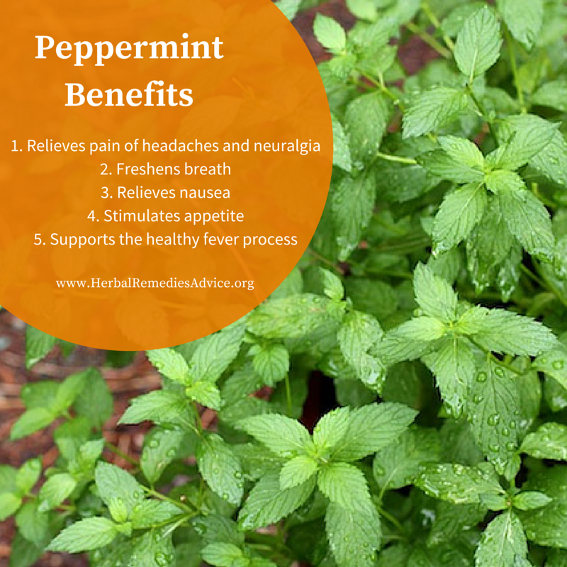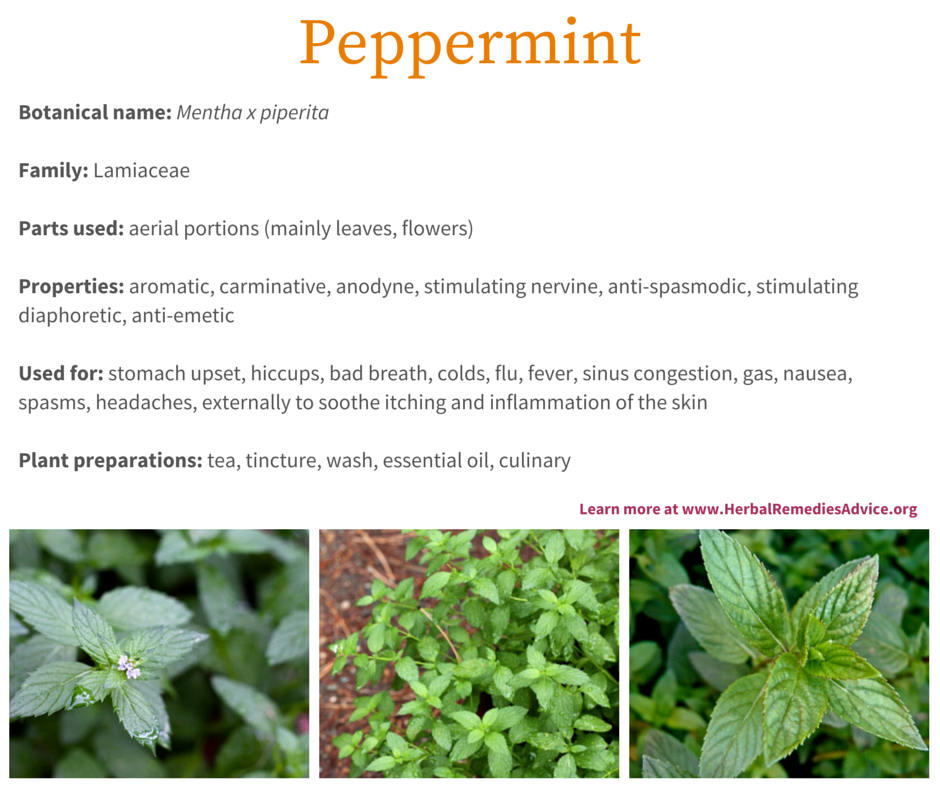Get weekly tips, recipes, and my Herbal Jumpstart e-course! Sign up for free today.

Peppermint Health Benefits
Share this! |
|
It’s easy to overlook peppermint health benefits. I mean everyone knows about peppermint. If someone is going to have one herbal tea in their house it most often is peppermint tea. It’s famous in candies such as peppermint drops and candy canes and is a frequent flavoring in chewing gum, liqueurs and even over-the-counter medicine.
It’s almost as if peppermint has been overdone and it’s easy for us to brush aside common herbs as we race for more exotic plants. But that is why I like to focus on individual plants: so that we can spend a significant amount of time really getting to know the plant, so that we can truly appreciate all it has to offer and fully recognize that the reason common plants are so… well, common, is because they can DO so much!
When’s the last time you had a strong brew of peppermint tea? Did you marvel at its complex energetic qualities? Were you astounded that while sipping the hot liquid you felt a distinctly cooling energy from your mouth, down your esophagus and into your stomach? Or were you just so relieved at how well it was quelling your sour stomach that you forgot to notice? Go on, drink some more. This sensation truly has to be felt in order to fully appreciate it.
This distinctly cooling action is due to the plant’s high menthol content. This volatile oil is present in many mints and is one way this plant offers us powerful medicine.
The active constituent in peppermint is menthol and is responsible for the cooling effect peppermint has. Menthol also inhibits the nerves that react to painful stimuli, giving relief to muscle spasms, coughs, intestinal cramping and more.
- Kristine Brown, Herbal Roots Zine: Peppermint
The Peppermint Herb
You’ll notice that peppermint has a somewhat different botanical name: Mentha x piperita. The “x” lets us know that this plant is a hybrid. Peppermint is a cross between spearmint (Mentha spicata) and water mint (Mentha aquatica). While many different mints have been in use throughout human history, it was only in the late 17th century that peppermint was recognized as a separate species in England. It was added to the England pharmacopeia in 1721.
Since we know peppermint so well there is one attribute we can’t overlook; it tastes great! If you’ve been studying herbalism for more than a couple of days, then it will come as no surprise to you that not all herbs taste good. It’s true!
Peppermint then becomes a powerful ally for those people with hypersensitive taste buds that are easily attacked by not-so-great tasting herbs.
Peppermint also offers some valuable nutrient qualities. One ounce of dried peppermint contains 540mg of calcium, 220mg of magnesium and 753 mg of potassium.
Peppermint Health Benefits as an Aromatic Carminative
Peppermint shines as an herb that helps with digestion in a myriad of ways.
Have a tummy ache? Try a cup of peppermint tea. Have a nervous stomach? Try a cup of peppermint tea. Have diarrhea? Try a cup of peppermint tea! Have gas and bloating after a meal? You guessed it! Try some peppermint tea!
Peppermint has the added bonus of freshening your breath. And, if you need it in a pinch, you can often find it at coffee shops and grocery stores.
Peppermint doesn’t just help with your every day or run-of-the-mill tummy aches. It has also been clinically proven to be helpful for people suffering with severe digestive disorders such as irritable bowel syndrome and ulcerative colitis although, for these complaints, peppermint oil is taken in an enteric coated capsule. This special capsule coating is strong enough to pass through the stomach and then dissolves in the intestines where the medicine is needed most.
I learned from 7Song that peppermint tea is a great cure for hiccups. It works!
From its stimulating, stomachic and carminative properties, it is valuable in certain forms of dyspepsia, being mostly used for flatulence and colic. It may also be employed for other sudden pains and for cramp in the abdomen; wide use is made of Peppermint in cholera and diarrhoea. - Maude Grieve, A Modern Herbal
Wondering where to buy peppermint oil or dried peppermint leaf in bulk? Mountain Rose Herbs provides incredibly strong and aromatic peppermint. Click on the peppermint links in this article to be directed to Mountain Rose Herbs and you will support this website in the process. Thank you!
Peppermint Health Benefits as an Anodyne
Peppermint works wonderfully to soothe pain. It is commonly used for headaches. As we’ve discussed, it can help a variety of painful digestive complaints.
It can be applied externally to relieve pain as well. A friend of mine with neuropathy in his feet due to diabetes swears that peppermint essential oil is the only thing that relieves his pain.
Peppermint can also relieve the itching and inflammation of sunburns, poison oak/ivy and hives. You can use peppermint tea as a wash or add a strong brew to bath water.
Oil
of Peppermint is rubefacient and anodyne. It is used alone or in
combination with other oils for the relief of neuralgia and toothache,
in both of which it is often very efficient. …Still it is used largely
to relieve local pain, especially that of burns and scalds.
- Felter’s Materia Medica, 1922
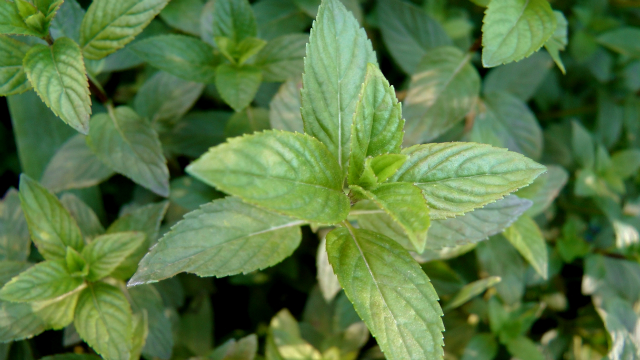 Mentha x piperita
Mentha x piperitaPeppermint Health Benefits as an Antispasmodic
Peppermint can ease tonic muscles. It can be used for menstrual cramps or a sore back. Have a tension headache? Try a poultice of peppermint over your forehead or at the base of your neck.
Peppermint Health Benefits as a Stimulating Herb
Peppermint is often referred to as a stimulating herb. It’s easy to envision coffee or tea when we talk about stimulating nervines since we know the caffeine content gives us that noticeable zing of temporary energy. And while peppermint doesn’t have the caffeine jolt, it does promote alertness. Just recently one of my clients told me he was able to wean himself off of coffee by drinking strong peppermint infusions instead.
Peppermint Health Benefits for Colds and the Flu
Peppermint has long been used to address fevers that accompany the flu. It opens the pores of the body, allowing the heat to escape and making it a great choice for fevers when the person is restless and feels hot.
A traditional western herbal formula is the combination of elder flowers (Sambucus nigra, S. cerulea), peppermint and yarrow.
An
infusion of equal quantities of Peppermint herb and Elder flowers (to
which either Yarrow or Boneset may be added) will banish a cold or mild
attack of influenza within thirty-six hours, and there is no danger of
an overdose or any harmful action on the heart.
- Maude Grieve, A Modern Herbal
Peppermint can also be used as an herbal steam to break up congestion in the lungs. Peppermint essential oil can also be inhaled with similar effects.
Peppermint possesses aromatic, sudorific, and antispasmodic properties. It is an efficient agent in spasms of wind, sickness, colic, diarrhoea, and other acute attacks of similar nature. It is generally exhibited in the warm infusion, which is to be prepared, and kept, while warm, in a covered vessel, so as to prevent the escape of steam. …it frequently gives relief after failure with all other means previously employed. - John G. Hatfield, Botanic Pharmacopeia, 1886
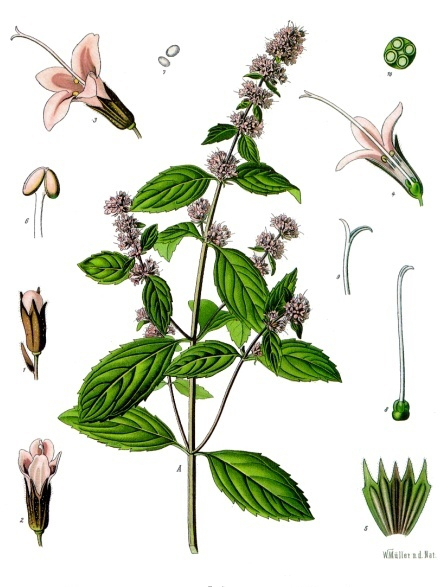 The Botany of Peppermint
The Botany of PeppermintPeppermint Uses
Peppermint can be used in a variety of ways.
It can be made into a tea by infusing a tsp or more into 8 ounces of just-boiled water. Be sure to steep the peppermint tea in a covered container to decrease the loss of volatile oils. In five minutes you’ll have a lovely tasting tea. Read further about the benefits of peppermint tea here.
Peppermint is commonly used as an essential oil. This can be used externally in ointments or taken internally. Please use caution when using any essential oil internally as it can cause serious problems if used incorrectly.
Infusing peppermint into oil leaves you with a peppermint oil that is great for sore muscles, pain, and cramping that can be used externally. It can also be used externally as a poultice or as a tea wash.
Special Considerations
Peppermint is generally safe for everyone.
In some sensitive individuals it can cause heartburn. Taken in excess it could dry up breast milk.
The Peppermint Herb
As a member of
the mint family, peppermint possesses the opposite leaves and square
stems that are an identifying characteristic for this family.
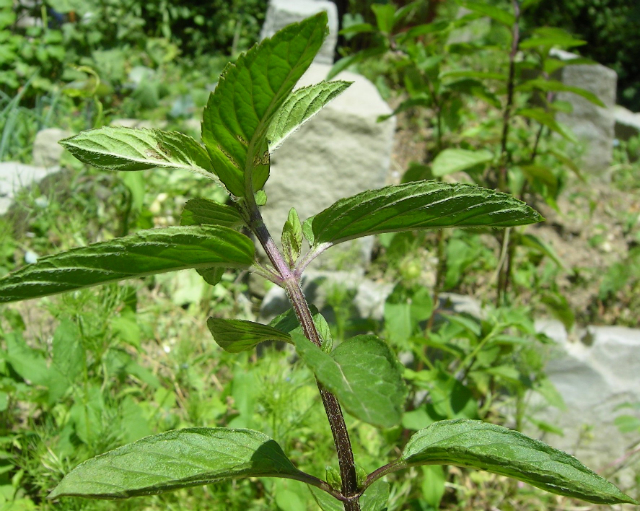
Peppermint flowers
are white to pink to purplish and are arranged in whorls around the
stem. Each individual peppermint flower has the characteristic lip shape of the
mint family.
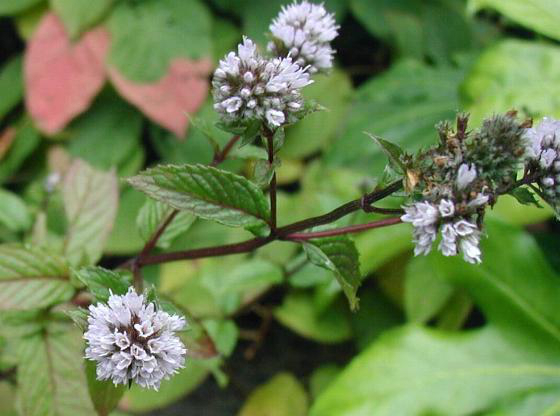
Peppermint grows anywhere from 12 – 35 inches tall.
Most peppermint does not produce viable seeds. The best way to propagate it is by root cuttings. Beware, the peppermint will take over wherever you plant it. One way to keep its growth in check is to plant it in a container. It prefers moist soils, but is famous for growing practically everywhere.
Try Peppermint and Share With Me!
A few years ago my friend Kimberly really inspired me to get out of my herbal rut and try favorite herbs in different ways. I would like to pass on that inspiration and really encourage people to use pepperming in ways they haven’t before. Have a headache? Try peppermint! Need to soothe an upset tummy? Reach for the peppermint. If you’ve never tried a pepperming oil infusion or a peppermint herbal steam, then do!
What's your favorite way to use peppermint? Are you inspired to try something new with peppermint? Let me know in the comments below!
This article was originally published on HerbMentor.com.

Rosalee is an herbalist and author of the bestselling book Alchemy of Herbs: Transform Everyday Ingredients Into Foods & Remedies That Healand co-author of the bestselling book Wild Remedies: How to Forage Healing Foods and Craft Your Own Herbal Medicine. She's a registered herbalist with the American Herbalist Guild and has taught thousands of students through her online courses. Read about how Rosalee went from having a terminal illness to being a bestselling author in her full story here.
